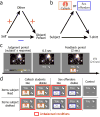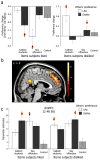Social manipulation of preference in the human brain
- PMID: 23664619
- PMCID: PMC3695714
- DOI: 10.1016/j.neuron.2013.03.023
Social manipulation of preference in the human brain
Abstract
Our preferences are influenced by what other people like, but depend critically on how we feel about those people, a classical psychological effect called "cognitive balance." Here, we manipulated preferences for goods by telling participants the preferences of strongly liked or disliked groups of other people. Participants' preferences converged to those of the liked group, but diverged from the disliked group. Activation of dorsomedial prefrontal cortex (dmPFC) tracked the discrepancy between one's own preference and its social ideal and was associated with subsequent preference change (toward the liked and away from the disliked group), even several months later. A follow-up study found overlapping activation in this same region of dmPFC with negative monetary outcomes, but no overlap with nearby activations induced by response conflict. A single social encounter can thus result in long-lasting preference change, a mechanism that recruits dmPFC and that may reflect the aversive nature of cognitive imbalance.
Copyright © 2013 Elsevier Inc. All rights reserved.
Figures




Similar articles
-
Neural Mechanisms Underlying Individual Differences in Control-Averse Behavior.J Neurosci. 2018 May 30;38(22):5196-5208. doi: 10.1523/JNEUROSCI.0047-18.2018. Epub 2018 May 14. J Neurosci. 2018. PMID: 29760183 Free PMC article.
-
Learning-induced plasticity in medial prefrontal cortex predicts preference malleability.Neuron. 2015 Jan 21;85(2):418-28. doi: 10.1016/j.neuron.2014.12.033. Neuron. 2015. PMID: 25611512 Free PMC article.
-
The selfless mind: How prefrontal involvement in mentalizing with similar and dissimilar others shapes empathy and prosocial behavior.Cognition. 2016 Dec;157:24-38. doi: 10.1016/j.cognition.2016.08.003. Epub 2016 Aug 29. Cognition. 2016. PMID: 27568587
-
The Dorsal Medial Prefrontal Cortex Responds Preferentially to Social Interactions during Natural Viewing.J Neurosci. 2016 Jun 29;36(26):6917-25. doi: 10.1523/JNEUROSCI.4220-15.2016. J Neurosci. 2016. PMID: 27358450 Free PMC article.
-
Private but not social information validity modulates social conformity bias.Hum Brain Mapp. 2019 Jun 1;40(8):2464-2474. doi: 10.1002/hbm.24536. Epub 2019 Jan 30. Hum Brain Mapp. 2019. PMID: 30697880 Free PMC article.
Cited by
-
Advice-taking as a bridge between decision neuroscience and mental capacity.Int J Law Psychiatry. 2019 Nov-Dec;67:101504. doi: 10.1016/j.ijlp.2019.101504. Epub 2019 Nov 26. Int J Law Psychiatry. 2019. PMID: 31785723 Free PMC article. Review.
-
Characterization of the Core Determinants of Social Influence From a Computational and Cognitive Perspective.Front Psychiatry. 2022 Apr 18;13:846535. doi: 10.3389/fpsyt.2022.846535. eCollection 2022. Front Psychiatry. 2022. PMID: 35509882 Free PMC article. Review.
-
Diversity of opinions promotes herding in uncertain crowds.R Soc Open Sci. 2022 Jun 22;9(6):191497. doi: 10.1098/rsos.191497. eCollection 2022 Jun. R Soc Open Sci. 2022. PMID: 35754989 Free PMC article.
-
Neural correlates of informational cascades: brain mechanisms of social influence on belief updating.Soc Cogn Affect Neurosci. 2015 Apr;10(4):589-97. doi: 10.1093/scan/nsu090. Epub 2014 Jun 28. Soc Cogn Affect Neurosci. 2015. PMID: 24974396 Free PMC article.
-
Social information use in adolescents with conduct problems and varying levels of callous-unemotional traits.JCPP Adv. 2022 Mar 5;2(1):e12067. doi: 10.1002/jcv2.12067. eCollection 2022 Mar. JCPP Adv. 2022. PMID: 37431497 Free PMC article.
References
-
- Abelson RP, Aronson E, McGuire WJ, Newcomb TM, Rosenberg MJ, Tannenbaum PH. Theories of cognitive consistency: A sourcebook. Chicago: Rand McNally; 1968.
-
- Botvinick MM. Conflict monitoring and decision making: reconciling two perspectives on anterior cingulate function. Cogn Affect Behav Neurosci. 2007;7:356–366. - PubMed
-
- Botvinick MM, Braver TS, Barch DM, Carter CS, Cohen JD. Conflict monitoring and cognitive control. Psychol Rev. 2001;108:624–652. - PubMed
Publication types
MeSH terms
Grants and funding
LinkOut - more resources
Full Text Sources
Other Literature Sources
Medical

